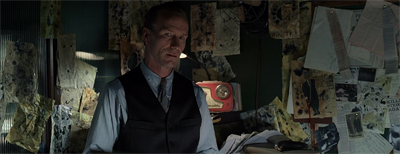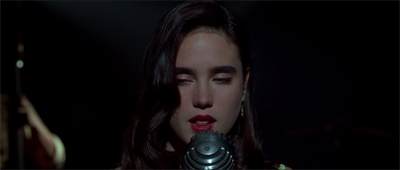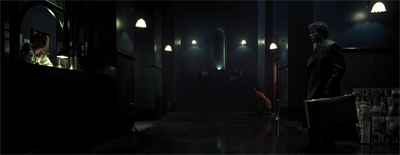We’re currently blogging as part of the “For the Love of Film Noir” blogathon (hosted by Ferdy on Films and The Self-Styled Siren) to raise money to help restore the 1950’s film noir The Sound of Fury (aka Try and Get Me). It’s a good cause which’ll help preserve our rich cinematic heritage for the ages, and you can donate by clicking here. Over the course of the event, running from 14th through 21st February, I’m taking a look at the more modern films that have been inspired or shaped by noir. Today’s theme is “cyber noir” – the unlikely combination of sci-fi and film noir to make an oh-so-tasty film.
A man jolts awake in a bathtub in a strange motel, and seems somewhat surprised by his surroundings. As seems to be mandatory in all good sleazy establishments, the light bulb on the ceiling swings back and forth – teasing illumination around the otherwise dark tiled room, but never showing everything. Confused, the resident stumbles to his feet, and searches frantically for what must be his clothes. However, there’s an unpleasant surprising waiting for him inside the anonymous cheap room: a dead body of a beautiful woman, carved and cut up in a mysterious spiral pattern. Our protagonist recoils, horrified by the discovery, and leaves the seedy dive as soon as possible. He assures himself, repeatedly, that it isn’t what it looked like. He isn’t a killer, he’s a good man.
However, it would be much easier to make that argument if he could remember anything before waking up in the water. Even his own name.
If that doesn’t sound like an introduction to a classic film noir, I don’t know what does. The mood, the sets, the shoots, the plot, they all scream “noir” – and wouldn’t seem out-of-place in a traditional black-and-white film. Don’t let the movie’s sci-fi trappings fool you (though occasionally certain elements, such as the stranger’s ESP, can be distracting), this is a pure hardboiled thriller about a world half empty. Fedoras and trench coats are in style, and nobody seems to know anything that’s going on.
We’re introduced to the man’s wife, who hasn’t heard from him in what seems to be weeks. A call from John’s doctor, the mysterious Doctor Schreber (who enjoys running rats through mazes), explains that he believes her husband has had a psychotic break from reality – that he has cracked under the pressure. As police officers begin investigating a series of brutal slayings, it becomes clear that the stranger (identified as John Murdock) is the primary suspect.
How do you prove your innocence when you can’t remember what happened? How can you even be sure that you are an innocent man without memories? “Whoever I am,” he insists, “I’m still me – and I am not a killer.” How can he be so sure, if he doesn’t know who “me” is? If all he knows is a dead body in his hotel room? Surely our experiences shape us, rather than the other way around – our memories shape our perception of self. “Will a man, given the history of a killer,” one character ponders, “continue in that vein? Or are we, in fact, more than the sum of our memories?”
What are the ingredients of the self? Is it, as Dr. Schreber suggests, “a touch of unhappy childhood, a dash of teenage rebellion, and, last but not least, a tragic death in the family”? Or is it something inherent to ourselves? When the whole world literally warps around, shifting like sand on a beach, what can we possibly hold on to? Is there something deeper underneath it all? Is there some core constant element that holds you together, and is it “what makes you human”?
Dark City is undoubtedly Alexis Proyas’ masterpiece. It’s a beautiful science fiction film, populated with great ideas – but also one that looks absolutely stunning. Although some film pundits might argue that The Matrix was the most prominent science-fiction film of the nineties to run with a noir aesthetic, I don’t believe it holds a candle to what Proyas has done here. It just takes all the core ideas of a film noir – those fundamental uncertainties about the world around us, and whether people ever reveal their true selves – and applies them perfectly to an engaging philosophical framework.
The aesthetic is undeniably influenced by those classic films (although, to be honest, there’s also something of German expressionist cinema in the city’s inconsistent and oppressive topography). Just take a look at some of these screenshots and tell me that the film doesn’t just ooze that classic allure. The production design of the film (down to the music as well), is absolutely stunning. It looks downright incredible – I can honestly say that I have seen very little that resembles it.
Proyas has taken a very skilled selection of actors. Kiefer Sutherland steals the show as the sinister Dr. Schreber, a man who isn’t quite all there (his name was borrowed from perhaps Freud’s most famous patient, author of Memoirs of my Mental Illness, populated with characters who have more than a slight resemblance to the more shadowy figures seen here). William Hurt is always reliable, as is Jennifer Connolly. Rufus Sewell is an interesting lead. He certainly has most of the character down, especially in relating Murdock’s confusion at his circumstance. However, it’s hard not to notice his accent slipping at several points during the film. And Richard O’Brien is always really frickin’ creepy.
The film itself isn’t flawless. While the practical effects and (especially the model work have aged really genuinely well (because they fit the film’s classical aesthetic), the computer-generated special effects have dated pretty damn badly. There’s also the rather awkward subplot about John’s special abilities. Though they are a science-fiction stable, these gifts don’t really work within the noir setting (especially given the camera tricks that Proyas uses to illustrate them).
However, these are minor complaints given the ambition and imagination of the film. Roger Ebert famously named the film as his favourite of the year it was released, citing its originality in a film market that was (increasingly) being dominated by sequels, spin-offs and remakes (it was nothing like as bad as it would become). You’ll note that I haven’t talked about the film in depth. Perhaps I will another time – but I don’t want to spoil it for anyone who has stumbled across this review and not yet seen it. Trust me, you’re doing yourself a disservice – you should go and watch it right now.
There’s really not much else to say. Dark City is a triumph of both genres, a film so good that Proyas himself has yet to match it (most of his films that followed have been more than slightly disappointing). It manages to not only look incredibly stylish, but its core is one packed with wonderful ideas and clever concepts which work remarkably well. There are occasional misteps, but they are easy to forgive in a movie that so clearly has its own voice.
If you enjoyed this post, please make a donation to the blogathon if you can. All funds go to help restore the classic The Sound of Fury, a very worthwhile cause and a wonderful contribution to make to the arts. Click the image below to donate.
Filed under: Non-Review Reviews | Tagged: alexis proyas, Dark City, Film noir, films, For the Love of Film Noir, For the Love of Film Noir blogathon, For the Love of Film Noir: The Film Preservation Blogathon, German Expressionism, kiefer sutherland, Movies, non-review review, review, Richard O'Brien, roger ebert, Rufus Sewell, Science fiction film, Sound of Fury |


























People take Kiefer Sutherland for granted after all those 24-themed drinking games but he is a good actor.
I’m going to be controversial and remark that Keifer Sutherland was brilliant as Jack Bauer for at least the first two seasons of the show. People underestimate how hard it is to make a guy like that relatable and how difficult it is to underscore an action hero like that’s humanity. I do think he got a bit more “autopilot” towards the end, but I’ll argue that Sutherland’s Jack Bauer was a great television performance.
I love this film, I rented it as a teenager because it had a cool cover and I was blown away by it. I’ve never met anyone else who has seen it.
Thanks for the reminder about this film I must hunt it down on dvd and buy it.
Thanks. I recommend the director’s cut, if only because it omits the opening narration which spoils half the film. It’s probably the best way to watch it.
This is one of the most amazing looking films I’ve ever seen. As if Edward Hopper and David Lynch got together and made a movie. I share your unease regarding John’s special abilities. This narrative element seems to come from nowhere and is never adequately explained. Still, small complaint about an otherwise stunning film.
Yep, I love it, even if the psi powers are a little disconcerting (even giving the end twist).
A hugely underrated film. A cult classic. A favourite of Roger Ebert if I remember correctly.
It was! His favourite film of 1998, if I recall correctly.
My problem with the movie is that the mystery is incredibly easy to figure out even if there wasn’t a narration in the beginning, and that the characters felt more like cyphers than characters. But that’s just me.
I like Dark City. I think it’s a well made and has a lot of interesting ideas, but it was too impersonal for me to fully enjoy it.
I kinda liked the disconnectedness of it; it’s so hauntingly eerie that I feel like I should be at a distance from it, arguably like the main character himself.